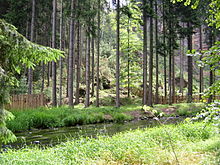Bohemian Switzerland
| Bohemian Switzerland National Park | |
|---|---|
 The symbol of Bohemian Switzerland, Pravčická brána, the largest sandstone arch in Europe | |
| Location | Czech Republic |
| Coordinates | 50°50′N 14°15′E / 50.833°N 14.250°E |
| Area | 79 km2 (31 sq mi) |
| Established | 2000 |
| Governing body | Správa ochrany přírody |
Bohemian Switzerland (Czech: České Švýcarsko; German: Böhmische Schweiz), also known as Czech Switzerland, is a nature region in the Elbe Sandstone Mountains in the northwestern Czech Republic, protected as a national park.
It has been a protected area (as Elbe Sandstone Mountains Protected Landscape Area) since 1972. The region along the right side of the Elbe became a national park in 2000 and is adjacent to the Saxon Switzerland National Park in Germany. Together with Saxon Switzerland, the region is known as Saxon-Bohemian Switzerland.
Etymology

The concept of Bohemian Switzerland developed in the 18th century as an extension of the Saxon Switzerland, a part of the Elbe Sandstone Mountains in Germany. The name was inspired by the Swiss artists Adrian Zingg and Anton Graff, who were reminded of their homeland by the geography of northern Bohemia.
Geography
Bohemian Switzerland covers the eastern part of the Czech side of the Elbe Sandstone Mountains. It is located northeast of Děčín, on right bank of the Elbe River, which briefly forms its border. It extends eastward into the Lusatian Mountains and westward into the Ore Mountains. Its highest elevation is the hill Růžovský vrch at 619 m (2,031 ft) above sea level.[1]
History

A large number of castles were built in the Bohemian Switzerland region in order to guard the trade routes. Several of these castles were also used as
The area first began to draw tourists in large numbers in the second half of the 19th century.
National park

As early as 1972, the whole of Bohemian Switzerland was placed under protection. When, in 1990, the status of
Sights

- : Prebischtor), the largest natural sandstone arch in Europe
- Kamenice Gorge, a rock ravine near Hřensko
- Šaunštejn Castle, a robber baron rock castle near Vysoká Lipa
- Mariina skála, a viewing point near Jetřichovice
- Vilemínina stěna, a viewing point near Jetřichovice
- Rudolfův kámen, a viewing point near Jetřichovice
- Pavlinino údolí, the deeply incised, romantic valley of the Chřibská Kamenice stream
- Falkenštejn Castle, rock castle
- Rock chapel in Všemily
- Malá Pravčická brána, natural sandstone arch
- Na Tokáni, historic inn and hostel
- The well tended villages with their Upper Lusatian houses
References
- ^ a b "Národní park České Švýcarsko – patří k nejkrásnějším místům v Evropě" (in Czech). CzechTourism. Retrieved 2023-04-09.
External links
- Official website
- Official tourist guide
- Bohemian-switzerland.cz – tourist guide
- Pravčice Gate website
- Awarded "EDEN - European Destinations of Excellence" non traditional tourist destination 2009
